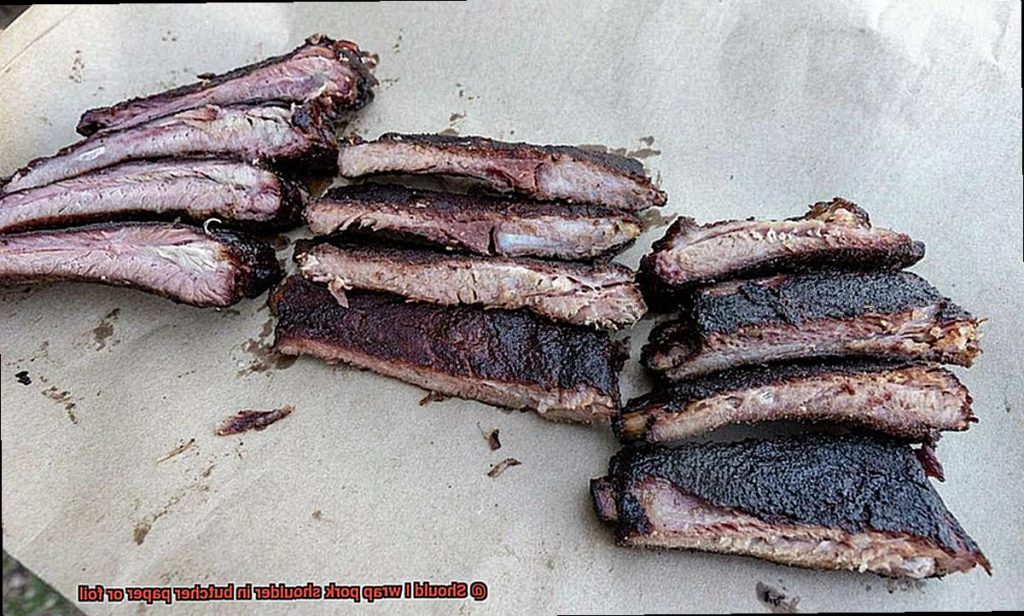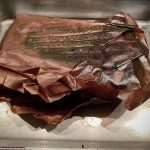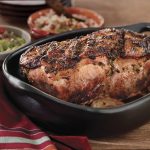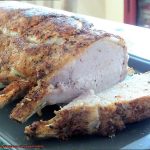The tantalizing aroma of a slow-cooked pork shoulder is enough to make anyone’s taste buds dance with joy. This succulent cut of meat is perfect for a variety of mouth-watering recipes, but when it comes to cooking it, the decision to wrap it in butcher paper or foil can be a game-changer.
Foil enthusiasts claim that it locks in the pork’s moisture and promotes even cooking. Meanwhile, those who prefer butcher paper argue that it allows the meat to breathe while still protecting it from drying out. So which one should you choose?
In this blog post, we’ll take a closer look at these two wrapping options and compare how they affect the flavor, tenderness, and juiciness of your pork shoulder. We’ll also explore different cooking methods that lend themselves better to butcher paper or foil wraps.
But before we delve into the nitty-gritty details, let’s start with the basics: understanding the differences between these two wraps. So sit back, relax, and prepare to discover everything you need to know about wrapping your pork shoulder like a pro – whether you’re hosting a backyard BBQ or just looking for an easy weeknight dinner option.
Contents
Benefits of Wrapping Pork Shoulder in Butcher Paper
When it comes to smoking pork shoulder, the choice between foil or butcher paper can cause quite a stir. While both methods have their advantages, today we’re going to explore the benefits of wrapping pork shoulder in butcher paper.
The main advantage of butcher paper is that it allows the meat to breathe while still retaining moisture. The porous paper permits air to circulate around the meat, preventing it from becoming too moist and mushy. This means your pork shoulder will be juicy and tender without being overly steamed.
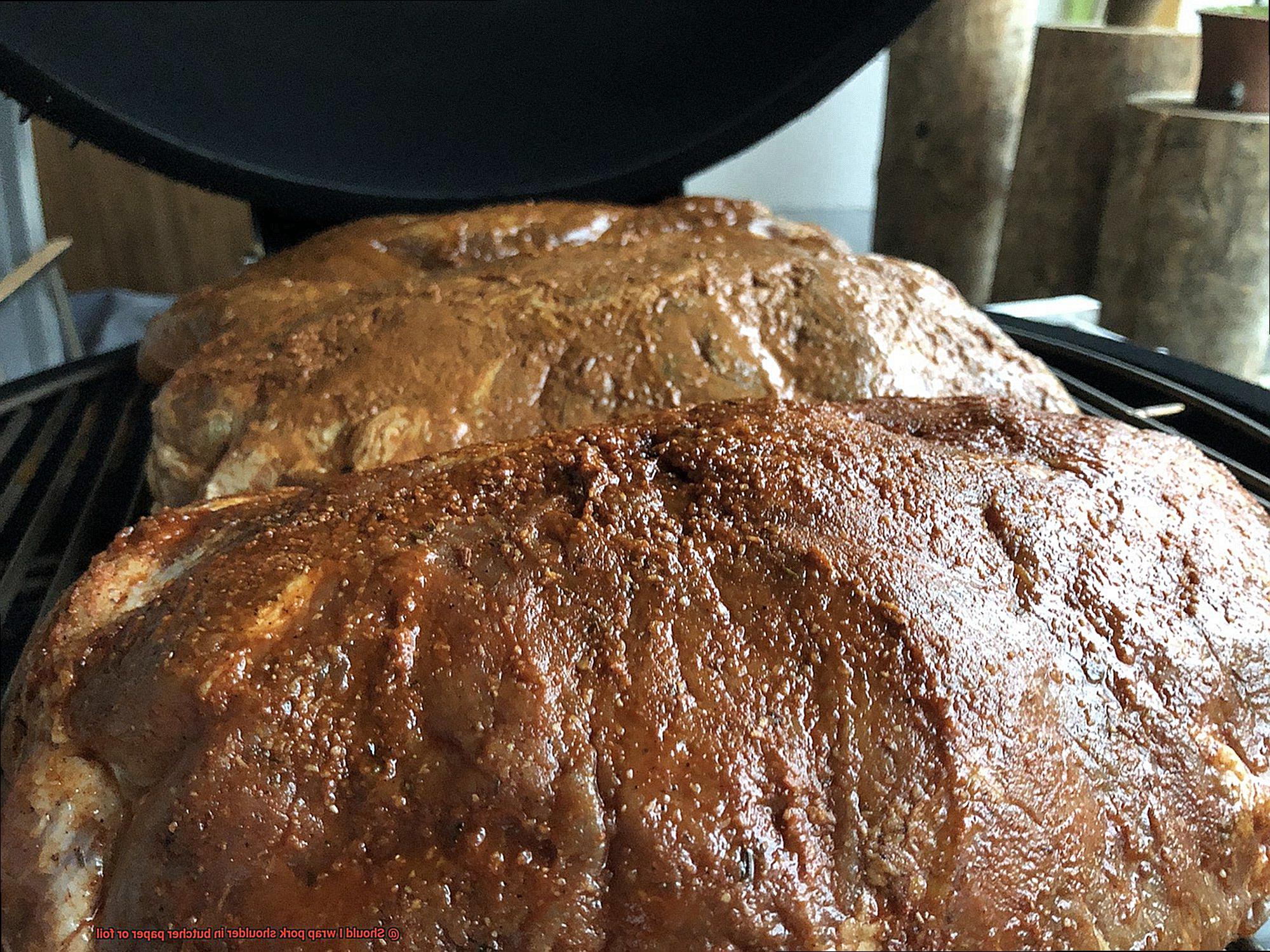
Butcher paper also helps to create a delicious bark on the outside of the meat. The bark is the caramelized crust that forms on the outside of the meat when it’s cooked low and slow. Butcher paper helps create this bark by allowing the meat to absorb smoke and other flavors from the grill or smoker while still protecting it from drying out.
Moreover, butcher paper is a more eco-friendly option than foil. Foil cannot be recycled and takes hundreds of years to decompose in a landfill, while butcher paper is biodegradable and can be composted. By choosing butcher paper, you’re not only enjoying delicious pork but also contributing to saving the environment.
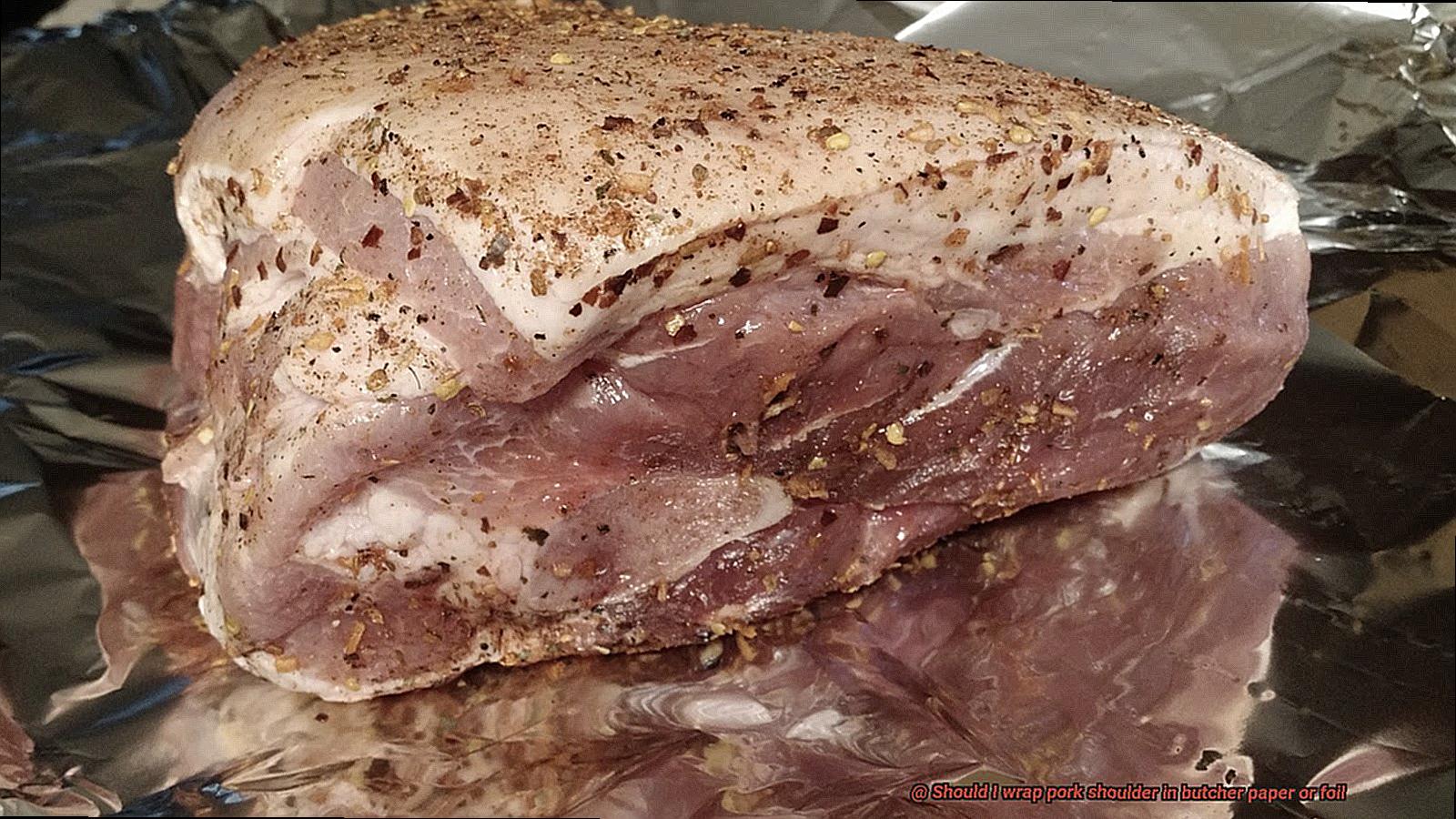
Disadvantages of Wrapping Pork Shoulder in Butcher Paper
While it may seem like a good idea, there are some disadvantages that you should consider. As an expert on this topic, I’ve done some research and compiled some important notes so that you can make an informed decision.
One of the main drawbacks of using butcher paper is that it may not retain moisture as well as foil does. This can lead to your meat drying out and becoming tough, which is not what you want when you’re aiming for a juicy and tender pulled pork. Don’t let your hard work go to waste by choosing the wrong wrapping material.
Additionally, butcher paper may not provide a tight enough seal around the pork shoulder, allowing air and moisture to escape. This can affect the cook time and overall quality of the meat. You want to ensure that your meat retains all its flavor and moisture, so make sure to choose a wrapping material that provides a secure seal.
Another disadvantage of using butcher paper is that it may not provide as much protection from smoke and heat as foil does. This can result in uneven cooking, with some areas possibly burnt or overcooked. You don’t want to end up with unevenly cooked meat, so choose the right wrapping material that can provide adequate protection.
Lastly, while butcher paper is more eco-friendly than foil, it can still contribute to waste if not disposed of properly. It may also be more difficult to recycle than foil in some areas. If sustainability is important to you, make sure to dispose of your butcher paper properly.
Benefits of Wrapping Pork Shoulder in Foil
If you’re a fan of juicy, succulent meat, then you’ll want to know about the benefits of wrapping it in foil during the cooking process. Trust me, as an expert on the topic, I’ve uncovered many advantages to using aluminum foil to wrap your pork shoulder.
Firstly, wrapping pork shoulder in foil helps to retain moisture. As the meat cooks, it releases juices that can easily evaporate and leave the meat dry. However, by wrapping the pork in foil, you create a barrier that traps those delicious juices and keeps them from escaping. This means you’ll be rewarded with a tender and juicy pork shoulder that’s sure to impress.
But that’s not all – another benefit of wrapping pork shoulder in foil is that it helps to distribute heat evenly. When you wrap the meat in foil, it creates a pocket of hot air that surrounds the pork. This hot air helps to cook the meat more evenly, so you don’t end up with overcooked or undercooked spots. This is especially important when cooking for a large group of people, as it ensures everyone gets a perfectly cooked piece of meat.
In addition to retaining moisture and distributing heat, wrapping pork shoulder in foil also helps to protect the meat from burning. We all know that crispy exterior can be delicious, but too much burning can result in a bitter taste. Wrapping the pork in foil helps to prevent burning by creating a barrier between the meat and the heat source. This means you’ll get that perfect golden-brown crust without any unwanted bitterness.
And last but not least – wrapping pork shoulder in foil can help to speed up the cooking process. The foil traps heat and moisture around the meat, resulting in faster cooking times. So whether you’re short on time or need to cook a large amount of pork shoulder quickly, wrapping it in foil can be a game-changer.
Disadvantages of Wrapping Pork Shoulder in Foil
It’s convenient and promises to retain moisture, but there are some significant disadvantages to consider when using this method.
One major issue is the impact on texture and flavor. When tightly wrapped in foil, the meat is essentially being cooked in its own juices and steam, which can result in a softer texture and less smoky flavor. And let’s be real – who doesn’t love that smoky flavor?
Another drawback with foil is its impact on bark formation. The crispy outer layer is highly prized by barbecue enthusiasts, but when wrapped in foil, it can become soft and mushy.
But wait, there’s more. Using foil can also trap too much moisture inside the meat, leading to a soggy texture and difficulty achieving the desired level of tenderness. The solution? Butcher paper allows for some moisture to escape while still keeping the meat moist and flavorful.
Lastly, foil makes it difficult to monitor the internal temperature of the meat accurately. It’s so tightly wrapped that inserting a thermometer becomes quite tricky. This can lead to overcooked or undercooked meat – a major disappointment for any barbecue enthusiast.
Factors to Consider When Choosing Between Butcher Paper and Foil
This decision can make or break the final result of your dish, so it’s crucial to consider several factors before making a choice.
Firstly, think about the outcome you desire. Do you want a crispy bark or a tender and moist meat? If you’re after a crispy bark, foil may not be the best option as it traps in moisture, which can soften the bark and create a less desirable texture. On the other hand, butcher paper allows for better air circulation and can help maintain a crispier bark. The paper also absorbs some of the meat’s natural juices and fats, which can enhance the flavor.
However, if you’re aiming for a tender and juicy meat, foil may be the better choice as it retains more moisture. This can result in a succulent end product that literally melts in your mouth. Butcher paper allows for more evaporation, which can lead to a drier meat. So consider your preference and what suits your recipe best.
Another factor to consider is cooking time. If you’re planning on wrapping your pork shoulder for a longer period of time, butcher paper may be better suited for the job. The paper is more breathable than foil and can withstand higher temperatures, making it ideal for longer cooks. Foil may cause the meat to steam and become mushy if left wrapped for too long.
Lastly, think about your personal preference and cooking style. Some pitmasters swear by using only one method over the other, while others prefer to experiment with both to see which yields the best results for their specific recipe and cooking technique. It’s all about finding what works best for you and your taste buds.
In5BHYIvrTo” >
Conclusion
To wrap or not to wrap, that is the question. When it comes to pork shoulder, the decision of whether to use butcher paper or foil can make a world of difference in the final product. Each option has its own unique benefits and drawbacks, so it ultimately depends on your personal preference and desired outcome.
Butcher paper is a great choice for those who want a crispy bark on the outside of their meat while still retaining moisture. The porous nature of the paper allows for better air circulation, resulting in a more flavorful cut. Plus, it’s an eco-friendly option that won’t harm the environment. However, it may not provide enough protection from smoke and heat, and could result in drier meat.
Foil, on the other hand, is perfect for those who want to retain moisture and cook their meat evenly. It’s also great at protecting against burning and can speed up cooking times. But be warned – using foil may result in a softer texture and less smoky flavor.
When making your choice between butcher paper or foil, consider factors such as cooking time, personal preference, desired outcome, and cooking style. Don’t be afraid to experiment with both methods to see which one works best for your specific recipe and technique.
In the end, no matter which method you choose, patience is key. With attention to detail and a little bit of TLC during the cooking process, you’ll end up with a mouth-watering cut of meat that will have everyone begging for seconds.

